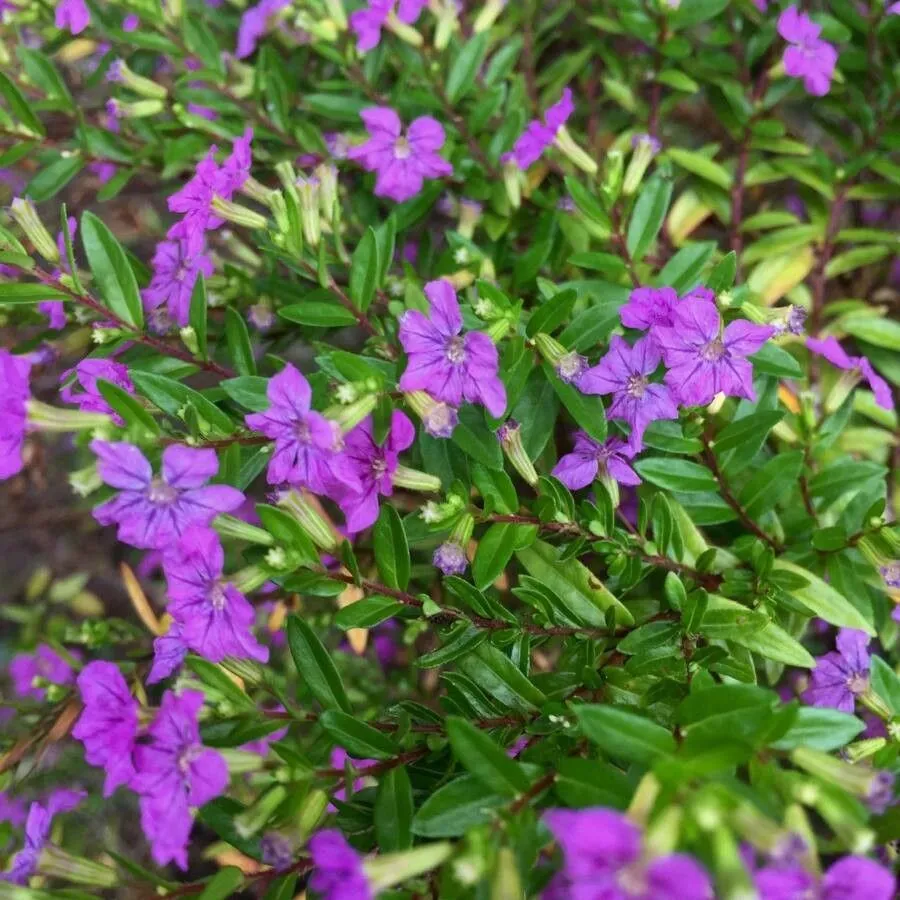
Author: Kunth
Bibliography: F.W.H.von Humboldt, A.J.A.Bonpland & C.S.Kunth, Nov. Gen. Sp. 6: 199 (1824)
Year: 1824
Status: accepted
Rank: species
Genus: Cuphea
Vegetable: Unknown
Observations: Mexico to C. America
Mexican-heather, scientifically known as Cuphea hyssopifolia, is a cherished plant celebrated for its delicate beauty and ease of care. First described in 1824 by the notable botanists Humboldt, Bonpland, and Kunth in their work “Novarum Genera et Species Plantarum,” the Mexican-heather has since enamored gardeners and horticulturists with its charming appearance and versatile growing capabilities.
Belonging to the Lythraceae family, this resilient plant originated from the lush landscapes of Mexico and Central America. Its history is enshrouded in the rich tapestry of these regions, thriving in their warm climates and adapting remarkably well to cultivation in various environments around the globe.
Mexican-heather typically features small, vibrant green leaves that create a fine-textured foliage, providing an elegant backdrop for its profusion of tiny, tubular flowers. These flowers, often found in shades of lavender, pink, and white, bloom prolifically throughout the growing season, attracting pollinators such as bees and butterflies, making it a delightful addition to any garden focused on biodiversity.
Not just an aesthetic delight, Cuphea hyssopifolia is also noted for its resilience and low-maintenance nature. It can be grown as a perennial in warmer climates or as an annual in regions with colder winters. The plant favors well-drained soil and thrives in full sun to partial shade, reducing the gardener’s efforts in providing constant care.
The allure of the Mexican-heather extends beyond its ornamental value, as it plays a role in traditional landscaping and as a filler plant in pots and borders. Its ability to grow in harmony with other plants, coupled with its minimal watering needs once established, makes it a pragmatic choice for both novice and experienced gardeners.
In summary, Cuphea hyssopifolia, or Mexican-heather, is a small but mighty plant that melds beauty, simplicity, and practicality. Whether gracing a garden bed or a patio container, its year-round blooming period and minimal care requirements ensure it remains a staple in the horticultural world, treasured as much today as when it was first documented nearly two centuries ago.
Eng: false heather, mexican-heather
Deu: ysopblättriges köcherblümchen, falsches heidekraut
Por: cufeia, falsa-érica, érica
Swe: isopskufea
Spa: romerito
En: Mexican-heather, False heather, Elfin bush, Elfin Herb, Hyssop-leaf Waxweed, Mexican Heather
As: পানিকা ফুল
Zh: 細葉雪茄花
Fi: Sinitulitorvi
Fr: Cuphée à feuilles d’hysope, Etoile du Mexique
De: Falsches Heidekraut, Ysopblättriges Köcherblümchen
El: Κοφέα
Pt: Falsa-érica, Cufeia, Érica
Es: Romerito
Sv: Isopskufea
Zh-tw: 細葉雪茄花
Vi: Cẩm tú mai
© copyright of the Board of Trustees of the Royal Botanic Gardens, Kew.
© copyright of the Board of Trustees of the Royal Botanic Gardens, Kew.
© copyright of the Board of Trustees of the Royal Botanic Gardens, Kew.
Taken Dec 2, 2020 by Ribeiro Thaís (cc-by-sa)
Taken Aug 13, 2019 by Borgess Lais (cc-by-sa)
Taken May 6, 2018 by Hugo SANTACREU (cc-by-sa)
Taken Jun 16, 2019 by H J (cc-by-sa)
Taken Oct 5, 2018 by Dieter Wagner (cc-by-sa)
Taken Jul 23, 2020 by Heiata RAVATUA-SMITH (cc-by-sa)
Taken May 6, 2018 by Hugo SANTACREU (cc-by-sa)
Taken Aug 28, 2020 by Werner Rom (cc-by-sa)
Taken Apr 23, 2021 by Trap Hers (cc-by-sa)
Taken Oct 5, 2018 by Dieter Wagner (cc-by-sa)
Taken Sep 4, 2021 by Fernando Q (cc-by-sa)
Taken Sep 16, 2018 by Hugo SANTACREU (cc-by-sa)
Taken Aug 13, 2021 by ioannis mhtsos (cc-by-sa)
Taken Dec 22, 2021 by Muñoz cecilia (cc-by-sa)
Taken Feb 20, 2021 by Saul Hernandez (cc-by-sa)
Taken Apr 17, 2019 by OTS – O. Vargas (cc-by-nc-sa)
Taken Jul 27, 2021 by Dieter Albrecht (cc-by-sa)
Taken Apr 17, 2019 by OTS – O. Vargas (cc-by-nc-sa)
Taken Mar 1, 2022 by Max (cc-by-sa)
Taken Sep 12, 2020 by Maarten Vanhove (cc-by-sa)
Taken Nov 12, 2022 by Viktor netek (cc-by-sa)
Taken Apr 16, 2021 by vasquez mafer (cc-by-sa)
Taken Aug 7, 2022 by jean-michel Ruscica (cc-by-sa)
Taken Feb 22, 2021 by Dhriti Singh (cc-by-sa)
Taken Oct 16, 2019 by Rosewood Ren (cc-by-sa)
Taken Sep 9, 2021 by Manū (cc-by-sa)
Taken Oct 5, 2021 by Ramírez Pérez (cc-by-sa)
Family: Myrtaceae Author: (F.Muell.) K.D.Hill & L.A.S.Johnson Bibliography: Telopea 6: 402 (1995) Year: 1995 Status:…
Family: Rubiaceae Author: Pierre ex A.Froehner Bibliography: Notizbl. Bot. Gart. Berlin-Dahlem 1: 237 (1897) Year:…
Family: Sapindaceae Author: Koidz. Bibliography: J. Coll. Sci. Imp. Univ. Tokyo 32(1): 38 (1911) Year:…
Family: Asteraceae Author: A.Gray Bibliography: Pacif. Railr. Rep.: 107 (1857) Year: 1857 Status: accepted Rank:…
Family: Fabaceae Author: Medik. Bibliography: Vorles. Churpfälz. Phys.-Ökon. Ges. 2: 398 (1787) Year: 1787 Status:…
Family: Aspleniaceae Author: (Cav.) Alston Bibliography: Bull. Misc. Inform. Kew 1932: 309 (1932) Year: 1932…